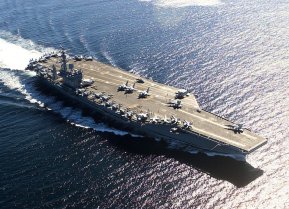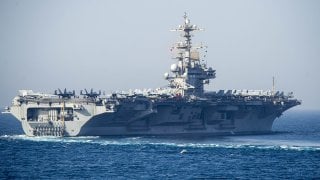USS George HW Bush: The Last Nimitz-Class Aircraft Carrier Is a Masterpiece
The Navy expects the USS George H.W. Bush to remain in service through the 2050’s. During the Covid-19 pandemic, the $6.5 billion carrier underwent extensive maintenance and repairs in Norfolk and re-entered service in 2021.
Meet the USS George HW Bush: America’s fleet of top-of-the-line aircraft carriers plays a significant role in deterring potential adversaries from striking U.S. interests.
Most recently, the White House deployed two carrier strike groups to the Eastern Mediterranean and Persian Gulf to thwart Iranian-backed groups in the region from expanding the ongoing Israel-Hamas war.
Analysts largely agree that the Lebanon-based Hezbollah group has likely limited its barrages toward the Jewish state because of the presence of these formidable carriers in the seas nearby. While a carrier strike group is comprised of a variety of vessels, the carrier and its air wing take on the principal role of providing primary offensive firepower if needed.
For this reason, in times of crisis, the question always asked first by leaders is: “Where are the carriers?”
The USS George H.W. Bush is the tenth and final Nimitz-class supercarrier to ever sail for the U.S. Navy. This massive ship is named to honor the 41st President of the U.S. and former Director of the CIA George H.W. Bush. Back in 1943, Bush became one of the youngest aviators to receive his wings just shy of turning nineteen years old.
During the Second World War, Japanese anti-aircraft fire hit Bush’s plane over the Pacific. A Navy submarine rescued Bush and he was later awarded three Air Medals and the Distinguished Flying Cross for his service.
A Brief Overview of the USS George H.W. Bush’s History
Northrop Grumman Shipbuilding Newport News was awarded the contract to construct CVN-77 back in 2001. Within two years, the ship’s keel laying ceremony was held.
When the George H.W. Bush was introduced into service, the ship joined nine other nuclear-powered Nimitz class aircraft carriers: USS Nimitz (CVN 68), Bremerton, WA USS Dwight D. Eisenhower (CVN 69), Norfolk, VA USS Carl Vinson (CVN 70), San Diego, CA USS Theodore Roosevelt (CVN 71), Norfolk, VA USS Abraham Lincoln (CVN 72), Newport News, VA USS George Washington (CVN 73), Yokosuka, Japan USS John C. Stennis (CVN 74), Bremerton, WA USS Harry S. Truman (CVN 75), Norfolk, and VA USS Ronald Reagan (CVN 76), San Diego.
Introducing the Nimitz-class
The Nimitz-class carriers measure 1,092 feet long and boast a massive flight deck over six acres in area. Initially developed into the 1960’s, the Nimitz carriers remain the backbone of the Navy’s fleet. Several enhancements differentiate this class from its predecessors, including reactor quantity and fuel output.

The previous Enterprise-class ships required eight reactors to function, while the Nimitz-class only needed two Westinghouse A4W nuclear reactors.
Nuclear power is a huge advantage for carriers since it enables ships to stay at sea for months at a time without needing to refuel and can generate power for propulsion in addition to electricity. Additionally, this newer class of ships can carry 90 percent more aviation fuel and 50 percent more ordnance than the older Forrestal-class carriers.
These floating airports can support some the U.S. military’s finest airframes, including the Navy’s F-35 Lightening II, F/A-18 Growler, and F-18 Super Hornet fighter jets. In addition to this aerial power, these carriers can pack an impressive stockpile of weapons.
The Nimitz-class carriers carry defensive equipment for use against hostile aircraft and missiles, including three RIM-7 Sea Sparrow or RIM-162 Evolved SeaSparrow Missile Mk 29 missile launchers.
What Makes the USS George H.W. Bush so Formidable at Sea?
The USS George H.W. Bush sports the same abilities as its sister ships. She is also the second carrier after CVN-76 to be equipped with a modernized island with a new radar tower.
This smaller island is positioned farther aft, which allows for greater flight deck access while reducing signature and electronic self-interference.
As detailed by Peter Suciu, the USS George H.W. Bush truly embodies the concept of a floating airport, “She can carry typically up to fifty-six fixed-wing aircraft including the F/A-18A/C and F/A-18E/F, Grumman EA-6B Prowler, and the Grumman E-2C Hawkeye, as well as up to 15 rotary aircraft including the Sikorsky SH-60F, HH-60H Seahawk and SH-60B Seahawks. With four C13-2 steam catapults and three mk7 mod 3-type arrester wires, the carrier can launch and recover aircraft rapidly and simultaneously. If necessary, crews can launch aircraft at a rate of one every 20 seconds.”
The Navy expects the USS George H.W. Bush to remain in service through the 2050’s. During the Covid-19 pandemic, the $6.5 billion carrier underwent extensive maintenance and repairs in Norfolk and re-entered service in 2021.
About the Author
Maya Carlin is an analyst with the Center for Security Policy and a former Anna Sobol Levy Fellow at IDC Herzliya in Israel. She has by-lines in many publications, including The National Interest, Jerusalem Post, and Times of Israel. You can follow her on Twitter: @MayaCarlin.
All images are Creative Commons.


